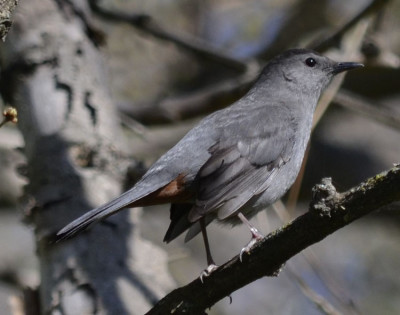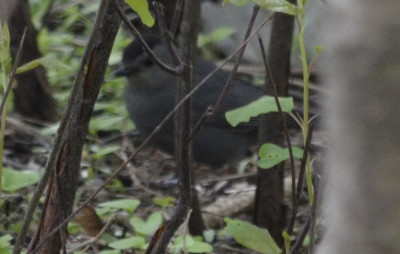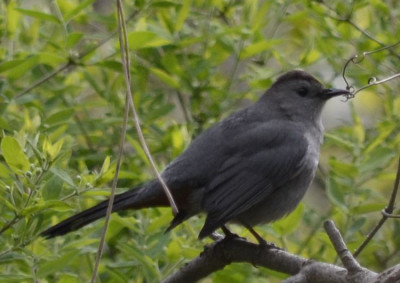I was standing up to my armpits in raspberry canes wondering how I get myself into these tangles when something began to mew under the dogwood bushes nearby. Lakeside Park in Mississauga is not a place I’d expect to meet a tabby especially since the east end of the park is an off-leash dog exercise yard with dozens of playful canines who’d like nothing better than to have a great game of chase.
As I listened the mews stopped and the worst possible impersonation of a European Starling and an American Robin and, maybe, a Phoebe started. So my cat was definitely a bird and definitely not a Mockingbird as they do a fabulous job of imitating everything from Robins to squeaky wrought iron gates.
There’s a patch of rusty red under the tail to add a dash of unexpected colour.
Back in my dim distant memories of exploring the Cataraqui Conservation Area near Kingston, the word Catbird drifted up in my mind.
Grey Catbirds Mimic Many Other Birds’ Calls
I squinted through my lens through the knotted undergrowth and there it was peeking back out at me. As if feeling sheepish, the Gray Catbird then flew up and perched on a branch posing for some quick photos with my Nikon. This was a pleasant surprise as Catbirds often spend all of their time lurking and skulking just out of focal range.
While perched, it burst out again into its enthusiastic if off-key and inaccurate mimicry songs. For good measure, the Catbird added a few mews which unlike its other calls actually do sound cat-like.
An Explosion of Catbirds in May
Over the next few days I seemed to find Catbirds all over: at Lakeside there were at least 6, at Arkendo at least 2, and even at Dingle Park in Oakville I found 1. Checking the BirdAlert weekly updates for Hamilton and Buffalo, I realized that these birds were actually migrating up and through southern Ontario. Only a few of them plan to stay and nest.
You usually see Catbirds skulking.
Catbirds’ Inexpert Flight Skills Match Inadequate Mimicry Talents
I also learned from my frequent sightings that they fly funny. To be specific, they fly as if they haven’t got a clue how. The stroke strongly for a few seconds, then stop and literally wobble in the air before stroking again. I imagine this is only when they are feeding rather than actually migrating or they would never get to their destination!
Still, this erratic flight makes them easy to differentiate from a distance from the gray-backs of Robins or the darker backs of Grackles. All three birds are roughly the same size and therefore easy to spot even in a woods.
Catbirds Are Often “Frugivorous” Don’t You Know
When reading up on them at AllAboutBirds.org, I learned a new word: frugivorous. Cunningly it simply said “Often frugivorous.” After I looked it up, I discovered that meant not that they were frugal, but that they enjoy eating fruit.
Further reading on the Cornell University website revealed they eat poison ivy berries. Oh happy days! So if a new patch of poison ivy appears in your yard this bird may be one of the ones that delivered the seeds to you.
Related Reading
Join In
Has anyone been mewing under your hedge who doesn’t have 4 legs? Please share your experiences with a comment.



